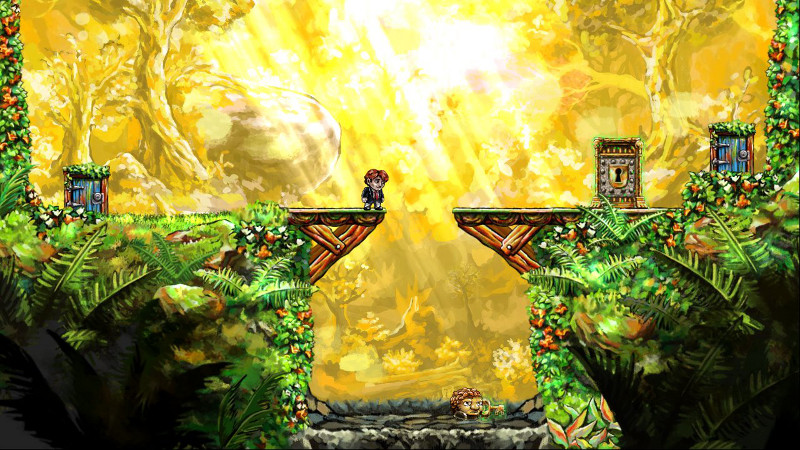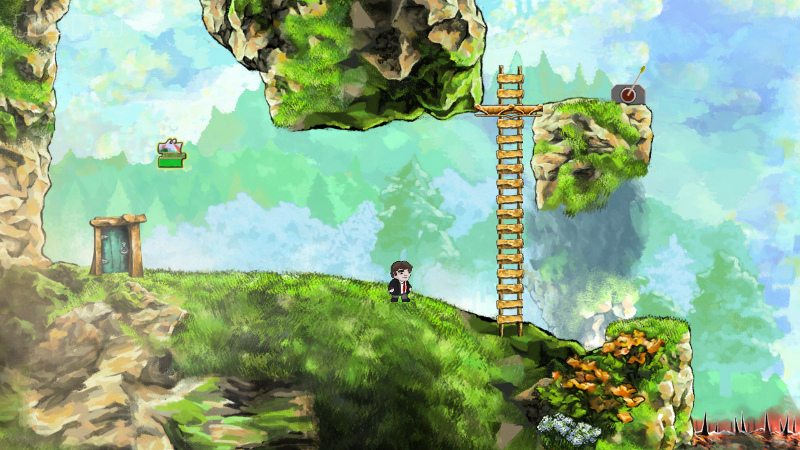Search
[{{{type}}}] {{{reason}}}
{{/data.error.root_cause}}{{{_source.title}}} {{#_source.showPrice}} {{{_source.displayPrice}}} {{/_source.showPrice}}
{{#_source.showLink}} {{/_source.showLink}} {{#_source.showDate}}{{{_source.displayDate}}}
{{/_source.showDate}}{{{_source.description}}}
{{#_source.additionalInfo}}{{#_source.additionalFields}} {{#title}} {{{label}}}: {{{title}}} {{/title}} {{/_source.additionalFields}}
{{/_source.additionalInfo}}- Details
- Category: Computer
- By J. Todd Cumming
- Hits: 8035
Braid (Mac)

Braid
Developed by: Number None
Released: August 6, 2008 (Xbox)
ESRB Rating: E10+, language, mild cartoon violence
Available on: Xbox, PS3, Windows, Mac (reviewed), Linux
Genre: 2D platform, puzzle
Number of players: 1
Price: $20
Should video games be considered art? It's a question that has been postulated since the first arcades opened. Most people – especially art experts who can tell the differences between a Monet and a Manet without batting an eye – would likely state that no, nothing mass produced and simplistic as a video game could possibly be considered real art.
But every once in a while a game comes along that pushes the boundary between pop culture and art. A game that not only entertains, it enlightens. A game that, when completed, the player feels somehow changed by the experience – in a positive way. Braid, the debut game from Jonathan Blow, is one of these games.
On the surface, Braid plays much like any other Mario-clone platformer. The player controls Tim through a surreal, gorgeously-painted landscape, jumping across clouds, bouncing off hedgehog-like creatures, and collecting puzzle pieces while looking for the exit. The visuals and beautiful soundtrack is enough to make this game stand out from many other platformers, but Braid adds another element that changes the nature of the game. With the press of a key, time can be reversed. For the most part, this is simply the mechanic used to reverse a bad decision that results in Tim's death. But soon enough, the player will discover that the ability to reverse time is a key component to solving the myriad of puzzles that can be found.

Strong Points: Beautiful graphics, lovely music, challenging puzzles and a thought-provoking storyline.
Weak Points: Only four types of enemies (including bosses). Not for impatient gamers.
Moral Warnings: Mild language.
Each world introduces a new mechanic in terms of manipulating time. For example, one will create a shadowy duplicate that imitates Tim's behavior before time is reversed. In another world, the flow of time only progresses as Tim moves to the right, and reverses as he moves to the left. Part of the challenge of the game is to learn how exactly each world's new mechanic affects the gameplay, and how to use it to complete the myriad of challenges. Given that each level in the game has a different solution, the player will feel a new sense of wonder with each new discovery.
The official Web site for Braid encourages the player to avoid looking up solutions and discover them on their own, and this is a sentiment I agree with. Part of the fun is figuring out the puzzles on your own, and experiencing the joy with solving each of the levels. I do admit that I did have to look up one of the solutions (not the one to “Fickle Companion,” largely considered to be the hardest level in the game), but only because I overlooked a rather simple gameplay mechanic that I had used in previous puzzles. Those who want to rush through a game in order to get to the “end game” or the boss battles will be disappointed. There are only two “boss battles” in the game – and that term is applied very loosely, partially because they appear in the middle of their worlds, and not the ends – or even at the end of the game. The fun of the game is found by trying to solve each of the puzzles individually.
Braid also ties in a fascinating yet enigmatic story, with elements of the tale serving as the introduction of each world. As the player makes his or her way through the game, the story deepens and it becomes apparent that symbolism runs throughout the entire experience. Even with the ending the player is left with more questions than answers. Why does the game begin with World 2? How does each world's mechanic reflect a different aspect of Tim's life? Is there really a girl, or is she symbolic of something greater? The hidden ending – if the player is determined enough to even attempt it – further deepens the mystery. There is a larger story here – one not readily forthcoming – that the player is left to contemplate. Jonathan Blow wisely is mum about the answers, leaving the interpretation of the elements of the game up to those who have played it.

Higher is better
(10/10 is perfect)
Game Score - 96%
Gameplay - 18/20
Graphics - 10/10
Sound - 10/10
Stability - 5/5
Controls - 5/5
Morality Score - 90%
Violence - 8/10
Language - 7/10
Sexual Content - 10/10
Occult/Supernatural - 10/10
Cultural/Moral/Ethical - 10/10
From a moral standpoint, there is little to be considered objectionable. There are a few vulgarities within the story elements of the game – one at the very end which is part of a historic quotation (and revealing the quote may be spoiling some of the plot) – but other than that, the content is no more objectionable than what can be found in most side-scrolling platformers, such as Super Mario World or Mega-Man.
Braid can be considered to be much more than just another game – it is one of the greatest examples of artistic expression. It succeeds in allowing the viewer to fully engage themselves within the messages the artist is trying to convey - not to be a mere observer of the events, but an active participant. Blow accomplishes what many artists strive for with stunning efficiency. He's created a game that is not just entertaining or challenging, but engaging and thought-provoking. For those that seek to immerse themselves in the game, they will find themselves affected by it, even to the very haunting end. Braid is not a game to be played. It is to be experienced.








